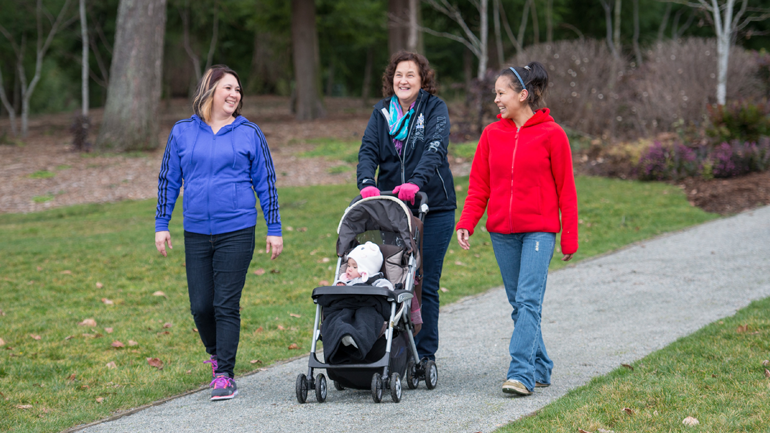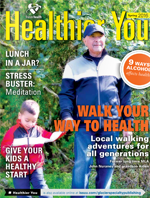
Get your family together, lace up your running shoes and get out on a trail in your community this weekend.
Our bodies need physical activity– it’s in our DNA and from the time we learn to walk as toddlers our bodies are programmed to move. For many reasons our modern lifestyle involves more sitting than ever before, whether we sit all day at our desk or binge-watch our favourite series on TV.
Movement and play are some of the best ways to prevent disease, strengthen our immune system to limit sickness, and keep our joints and muscles strong. Walking doesn’t require special gear and can be done by anyone – the key is to start making time in your day and helping your kids and aging family members stay active throughout their lives.
Walks for generations
Ages 0-4
Explore the big world through your young child's eyes
Getting your kids outside should start when they’re infants. Babies, like the rest of us, benefit from fresh air, and walking outside gives your baby an opportunity to explore the world. Every sight, sound and smell provides valuable experiences and teaches lessons about the world.
Not all trails are stroller-friendly so using a carrier or backpack can be another way to get your child out with you. As your child gets older and wants to move on their own, plan some playground or park time between walking sessions. Or bring along a tricycle, bike or scooter.
Stroller-friendly parks with trails and playgrounds
Ages 6 - 12
Make family time a bonus for your kids
Experts recommend that children get at least 60 minutes of physical activity every day to promote healthy growth and development. Walking with your children is a great way to spend quality family time.
The key to getting your children excited about being out for a walk is to make it fun. There are lots of ways to do this including:
- Create a scavenger hunt. Write down a list of things you want them to find – different kinds of trees, leaves, mushrooms, pine cones. When they find them cross them off the list.
- Take pictures. Give your child an old camera or camera/phone to take pictures along the route. Back home, the two of you can make a scrapbook of your adventure.
- Bring binoculars. Good for spotting birds, nests, squirrels, maybe mice.
- Bring a magnifying glass. Go on a bug hunt and look at ants, spiders and beetles.
- Turn your walk into an obstacle course. Suggest they, or all of you, climb over rocks or fallen trees, cross streams without getting wet, jump over cracks in sidewalks, run circles around a bench, touch a tree, or run very fast to a landmark up ahead.
- Collect leaves or rocks for an art project.
Remember to bring lots of water and snacks or even a picnic lunch to perk up the little ones’ energy. Try these kid-friendly parks with trails:
Ages 13 - 18
Set a positive challenge for your teens
When children become teenagers they experience many physical changes with their bodies. Getting at least 60 minutes of daily activity is especially important to avoid health problems in the future.
One way to keep your teenager engaged in physical activity is to provide a challenge. Here’s one suggestion: join a real-world treasure hunt with a geocaching app on your smart phone or with some other GPS-enabled device.
- Maps and clues will lead you to a hidden container with treasures ranging from the glory of victory to actual items left by other participants.
- Enroute, your hunt will take you through parks, city streets, or hiking trails. With almost three million geocaches worldwide, there’s bound to be a hidden treasure close by.
- Bring the family and your smartphone, or look for geocaching events near you.
See geocaching.com for more details.
Age 19+
Challenge yourself to 150 minutes or more a week
Adults should get 30 minutes of physical activity most days of the week. How you fit those 30 minutes in throughout the day – all at once or in bits – is up to you depending on your schedule. Weekend walks with your family are a great way to get your exercise and spend quality time with your kids.
For the other five days of the week, if you are just beginning an exercise plan start by walking on a smooth, flat surface like a sidewalk or a track. As you get stronger and want to seek more of a challenge, you can find many different trails in your community that suit your ability.
Try these easy- to medium-intensity walking trails that are good for the whole family too:
Ages 65+
Walk your way to a strong body
To age well your body needs to stay strong. Aiming for 30 minutes of exercise most days will help you meet this goal. You can start by breaking your daily walks into 10-minute chunks. As it becomes easier, try to include new challenges like:
- climb a hill
- extend the time you walk
- speed up your pace
- add an additional day of walking
Joining a walking group can be a great way to meet people and keep motivated.
Nordic walking, or urban poling, as it is also known, is a great way to work your whole body while maintaining balance. All you need are:
- comfortable, supportive walking shoes
- specifically-designed Nordic walking poles
Nordic walkers can be found on trails and roads using the poles to engage the upper body and back as well as the lower portion of the body. Nordic walking is a great activity for people who are walking to maintain fitness or are recovering from an injury like a hip replacement.
Get your 30 minutes on these trails:
- Burnaby Lake Trail, Burnaby
- The Vedder River Rotary Trail, Chilliwack
- Walking tool kit, Surrey and White Rock
For more information about urban poling, visit UrbanPoling.com
To find a walking trail near your community, check your community’s website or vancouvertrails.com/trails/
For more information about how to best remain active for any age group, see the Canadian 24-Hour Movement Guidelines.
Apps to make it real
-
C25K (Couch to 5K) helps to move users incrementally from a completely sedentary lifestyle to walking to running 5 km in 8 weeks, with audio coach, social support. Free.
-
Map My Walk lets you use your built-in smartphone GPS to track your route, providing you with distance, pace, calories burned, speed and elevation, with social media shareability. Free.
-
WorldWalking, devised by a cardiac rehab specialist in the UK, lets you choose a virtual route, i.e. the Machu Picchu trail and “complete” it by walking the equivalent steps, complete with route markers and photo sights. Free.
-
Nike+ Running an also be used for tracking walking.
This article was originally published in the Healthier You Spring 2016 magazine. Read more stories online.

